Nuclear Accident Emergency Response System: Radiation Field Estimation and Evacuation
Abstract
1. Introduction
- 1.
- Design a nuclear accident emergency response system consisting of radiation field estimation and evacuation. Based on UAV and bus collaboration, it can provide efficient, reliable and safe nuclear emergency response strategy for the decision-maker;
- 2.
- Analyze the optimal measurement coordinates considering the mobility of UAV. The CRLB-based coordinates optimization combined with UAV routing is formulated as an MINLP problem, and then solved by a two-stage solution procedure;
- 3.
- Improve the bus evacuation MILP model proposed by Bolia [16], in which both the evacuation time and the radiation exposure to evacuees are taken into consideration. The optimal evacuation route for buses can be directly obtained by commercial solvers.
2. Literature Review
3. UAV-Based Nuclear Radiation Field Estimation
3.1. Radiation Measurement Model
3.2. CRLB-Based Metric
3.3. Coordinates Optimization Problem Formulation
3.4. Two-Stage Solution Procedure
| Algorithm 1 Two-stage solution procedure. |
| Require:; ; ; v; the initial model parameters ; the initial UAV depots Ensure:;
|
| Algorithm 2 UAV-based nuclear radiation field estimation. |
| Require:; ; ; v; ; ; the time interval Ensure: The time-varying parameters of diffusion model
|
4. Bus-Based Nuclear Emergency Evacuation
4.1. Assumption and Description
- 1.
- People arrive at the nearest pickup point in advance to wait for evacuation, and the transfer time and radiation exposure are ignored;
- 2.
- The loading and unloading time of buses for pickup points and shelters are ignored;
- 3.
- The capacities of buses at different depots and the demands of different pickup points are known;
- 4.
- The locations of the depots, pickup points, and shelters are known and the travel time between them are constant;
- 5.
- Each pickup point has a particular shelter, i.e., a bus only takes evacuees from a pickup point to the assigned shelter during one trip, even if not fully loaded;
- 6.
- The shelter can accommodate all evacuees from the corresponding pickup points;
- 7.
- The radiation dose per second of each route and each pickup point are constant and known during one trip.
4.2. Mathematical Formulation
5. Simulation Results
- 1.
- More information can be obtained from more measurements, resulting in smaller parameter RMS error;
- 2.
- Based on the optimal measurement coordinates, even smaller parameter RMS error can be achieved with fewer measurements.
6. Conclusions
Author Contributions
Funding
Institutional Review Board Statement
Informed Consent Statement
Acknowledgments
Conflicts of Interest
References
- Hindmarsh, R. Nuclear Disaster at Fukushima Daiichi; Routledge: London, UK, 2013. [Google Scholar]
- Zou, Y.; Zou, S.; Niu, C. The optimization of emergency evacuation from nuclear accidents in China. Sustainability 2018, 10, 2737. [Google Scholar] [CrossRef]
- Hobeika, A.G.; Kim, S.; Beckwith, R.E. A decision support system for developing evacuation plans around nuclear power stations. Interfaces 1994, 24, 22–35. [Google Scholar] [CrossRef]
- Xue, H.; Gu, F.; Hu, X. Data assimilation using sequential Monte Carlo methods in wildfire spread simulation. ACM Trans. Model. Comput. Simul. (TOMACS) 2012, 22, 1–25. [Google Scholar] [CrossRef]
- Hirst, B.; Jonathan, P.; del Cueto, F.G.; Randell, D.; Kosut, O. Locating and quantifying gas emission sources using remotely obtained concentration data. Atmos. Environ. 2013, 74, 141–158. [Google Scholar] [CrossRef]
- Yang, H.; Huang, Y.; Center, S. Evaluating atmospheric pollution of chemical plant based on Unmanned Aircraft Vehicle (UAV). J. Geo-Inf. Sci. 2015, 17, 1269–1274. [Google Scholar]
- Martin, P.G.; Moore, J.; Fardoulis, J.S.; Payton, O.D.; Scott, T.B. Radiological assessment on interest areas on the sellafield nuclear site via unmanned aerial vehicle. Remote Sens. 2016, 8, 913. [Google Scholar] [CrossRef]
- Wang, J.; Wang, H.; Zhang, W.; Ip, W.H.; Furuta, K. Evacuation planning based on the contraflow technique with consideration of evacuation priorities and traffic setup time. IEEE Trans. Intell. Transp. Syst. 2012, 14, 480–485. [Google Scholar] [CrossRef]
- Sheffi, Y.; Mahmassani, H.; Powell, W.B. Evacuation studies for nuclear power plant sites: A new challenge for transportation engineers. ITE J. 1981, 51, 25–28. [Google Scholar]
- Zhou, M.; Dong, H.; Ning, B.; Wang, F.Y. Recent development in pedestrian and evacuation dynamics: Bibliographic analyses, collaboration patterns, and future directions. IEEE Trans. Comput. Soc. Syst. 2018, 5, 1034–1048. [Google Scholar] [CrossRef]
- Di Gangi, M.; Polimeni, A. A mesoscopic approach to model route choice in emergency conditions. In Proceedings of the International Conference on Optimization and Decision Science, Sorrento, Italy, 4–7 September 2017; pp. 547–555. [Google Scholar]
- Goerigk, M.; Grün, B.; Heßler, P. Branch and bound algorithms for the bus evacuation problem. Comput. Oper. Res. 2013, 40, 3010–3020. [Google Scholar] [CrossRef]
- Sun, Y.; Liu, H. Bus dispatching strategies in nuclear power plant emergent events. In Proceedings of the International Conference on Nuclear Engineering (ICONE), Tsukuba, Japan, 19–24 May 2019; p. 2004. [Google Scholar]
- Conn, A.; Gould, N.; Toint, P. A globally convergent Lagrangian barrier algorithm for optimization with general inequality constraints and simple bounds. Math. Comput. 1997, 66, 261–288. [Google Scholar] [CrossRef]
- Chen, B.; Li, Z.; Yang, Z. Accurate Parameter Estimation of Time-varying Nuclear Radiation Field with Mobile Sensors. In Proceedings of the 2021 40th Chinese Control Conference (CCC), Shanghai, China, 26–28 July 2021; pp. 5655–5660. [Google Scholar]
- Bolia, N.B. Operating strategies of buses for mass evacuation. Saf. Sci. 2019, 111, 167–178. [Google Scholar]
- Luhar, A.K. Analytical puff modelling of light-wind dispersion in stable and unstable conditions. Atmos. Environ. 2011, 45, 357–368. [Google Scholar] [CrossRef]
- Cao, X.; Roy, G.; Hurley, W.J.; Andrews, W.S. Dispersion coefficients for Gaussian puff models. Bound.-Layer Meteorol. 2011, 139, 487–500. [Google Scholar] [CrossRef]
- Lagzi, I.; Kármán, D. Simulation of the dispersion of nuclear contamination using an adaptive Eulerian grid model. J. Environ. Radioact. 2004, 75, 59–82. [Google Scholar] [CrossRef] [PubMed]
- Pontiggia, M.; Derudi, M.; Busini, V.; Rota, R. Hazardous gas dispersion: A CFD model accounting for atmospheric stability classes. J. Hazard. Mater. 2009, 171, 739–747. [Google Scholar] [CrossRef] [PubMed]
- Wang, R.; Chen, B.; Qiu, S.; Zhu, Z.; Ma, L.; Qiu, X.; Duan, W. Real-time data driven simulation of air contaminant dispersion using particle filter and UAV sensory system. In Proceedings of the 2017 IEEE/ACM 21st International Symposium on Distributed Simulation and Real Time Applications (DS-RT), Rome, Italy, 18–20 October 2017; pp. 1–4. [Google Scholar]
- Hiemstra, P.H.; Karssenberg, D. Assimilation of observations of radiation level into an atmospheric transport model: A case study with the particle filter and the ETEX tracer dataset. Atmos. Environ. 2011, 45, 6149–6157. [Google Scholar] [CrossRef]
- Fang, J.; Cheng, L. Comparison of algebraic reconstruction techniques and maximum likelihood-expectation maximization tomographic algorithms for reconstruction of Gaussian plume. In Proceedings of the 2014 7th International Conference on Biomedical Engineering and Informatics, Dalian, China, 14–16 October 2014; pp. 161–167. [Google Scholar]
- Homels, N.S.; Morawska, L. A review of dispersion modelling and its application to the dispersion of particles: An overview of different dispersion models available. Atmos. Environ. 2006, 40, 5902–5928. [Google Scholar]
- Kay, S. Fundamentals of Statistic Signal Processing: Estimation Theory; Prentice-Hall, Inc.: Upper Saddle River, NJ, USA, 1993. [Google Scholar]
- Ristic, B.; Gunatilaka, A.; Gailis, R. Achievable accuracy in Gaussian plume parameter estimation using a network of binary sensors. Inf. Fusion 2015, 25, 42–48. [Google Scholar] [CrossRef]
- Yang, Z.; Shi, X.; Chen, J. Optimal Coordination of Mobile Sensors for Target Tracking Under Additive and Multiplicative Noises. IEEE Trans. Ind. Electron. 2014, 61, 3459–3468. [Google Scholar] [CrossRef]
- Xu, S.; Ou, Y.; Wu, X. Optimal Sensor Placement for 3-D Time-of-Arrival Target Localization. IEEE Trans. Signal Process. 2019, 67, 5018–5031. [Google Scholar] [CrossRef]
- Zhang, Y.; Li, Y.; Zhang, Y.; Jiang, T. Underwater Anchor-AUV Localization Geometries With an Isogradient Sound Speed Profile: A CRLB-Based Optimality Analysis. IEEE Trans. Wirel. Commun. 2018, 17, 8228–8238. [Google Scholar] [CrossRef]
- Niu, R.; Varshney, P.K. Target Location Estimation in Sensor Networks With Quantized Data. IEEE Trans. Signal Process. 2006, 54, 4519–4528. [Google Scholar] [CrossRef]
- Ho, K.C.; Lu, X.; Kovavisaruch, L. Source Localization Using TDOA and FDOA Measurements in the Presence of Receiver Location Errors: Analysis and Solution. IEEE Trans. Signal Process. 2007, 55, 684–696. [Google Scholar] [CrossRef]
- Dhamala, T.N.; Pyakurel, U.; Dempe, S. A critical survey on the network optimization algorithms for evacuation planning problems. Int. J. Oper. Res. 2018, 15, 101–133. [Google Scholar]
- Pourrahmani, E.; Delavar, M.R.; Pahlavani, P.; Mostafavi, M.A. Dynamic evacuation routing plan after an earthquake. Nat. Hazards Rev. 2015, 16, 04015006. [Google Scholar] [CrossRef]
- Pereira, V.C.; Bish, D.R. Scheduling and routing for a bus-based evacuation with a constant evacuee arrival rate. Transp. Sci. 2015, 49, 853–867. [Google Scholar] [CrossRef]
- Dikas, G.; Minis, I. Solving the bus evacuation problem and its variants. Comput. Oper. Res. 2016, 70, 75–86. [Google Scholar] [CrossRef]
- Adhikari, I.M.; Pyakurel, U.; Dhamala, T.N. An integrated solution approach for the time minimization evacuation planning problem. Int. J. Oper. Res. 2020, 17, 27–39. [Google Scholar]
- He, X.; Zheng, H.; Peeta, S. Model and a solution algorithm for the dynamic resource allocation problem for large-scale transportation network evacuation. Transp. Res. Procedia 2015, 7, 441–458. [Google Scholar] [CrossRef][Green Version]
- Goerigk, M.; Deghdak, K.; Heßler, P. A comprehensive evacuation planning model and genetic solution algorithm. Transp. Res. Part E Logist. Transp. Rev. 2014, 71, 82–97. [Google Scholar] [CrossRef]
- Urbanik, I. Evacuation time estimates for nuclear power plants. J. Hazard. Mater. 2000, 75, 165–180. [Google Scholar] [CrossRef]
- Tan, K.; Yang, L.; Liu, X.; Xu, Y.; Lin, J.; Wang, X.; Wang, F.Y. An IVC-Based Nuclear Emergency Parallel Evacuation System. IEEE Trans. Comput. Soc. Syst. 2021, 8, 844–855. [Google Scholar] [CrossRef]
- Huang, C.; Nie, S.; Guo, L.; Fan, Y.R. Inexact Fuzzy Stochastic Chance Constraint Programming for Emergency Evacuation in Qinshan Nuclear Power Plant under Uncertainty. J. Environ. Inform. 2017, 30, 63–78. [Google Scholar] [CrossRef]
- Yao, C.; Chen, S.; Yang, Z. Evacuation Problem Under the Nuclear Leakage Accident. In Proceedings of the 2021 40th Chinese Control Conference (CCC), Shanghai, China, 26–28 July 2021; pp. 1703–1708. [Google Scholar]
- Ucinski, D. Optimal Measurement Methods for Distributed Parameter System Identification; CRC Press: Boca Raton, FL, USA, 2004. [Google Scholar]
- David Edward, G. Genetic Algorithms in Search, Optimization, and Machine Learning; Addison-Wesley: Reading, MA, USA, 2002. [Google Scholar]

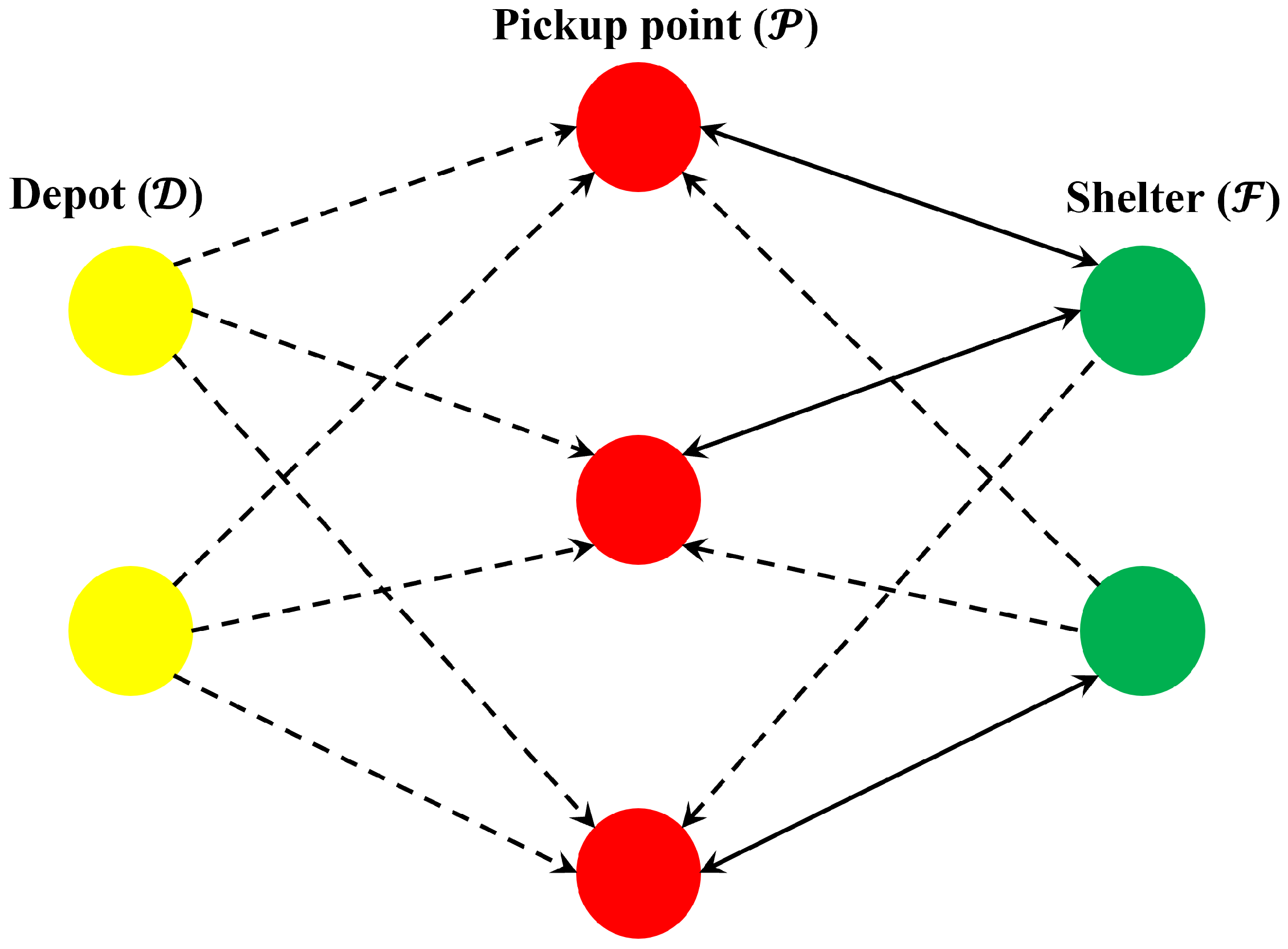
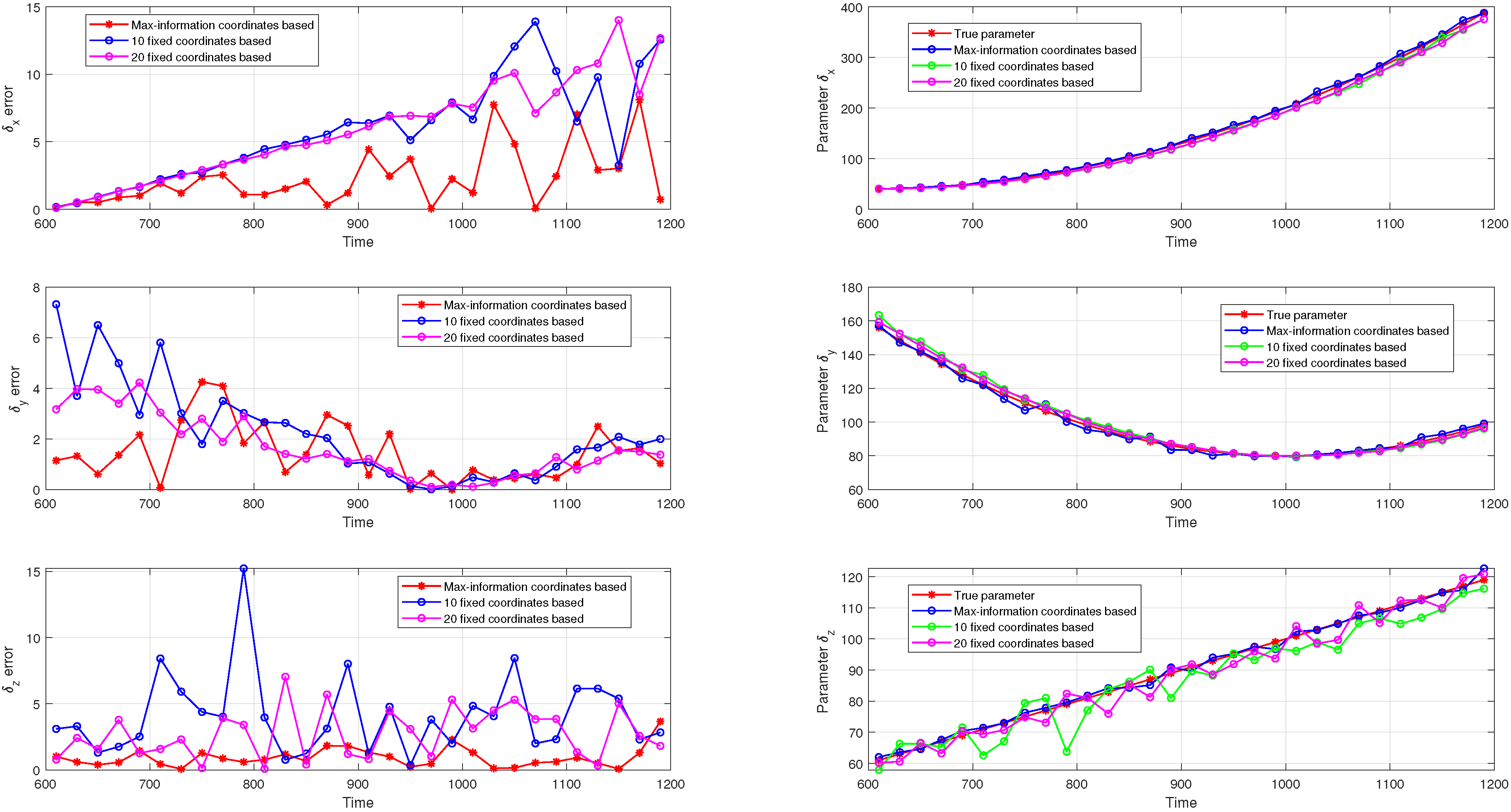
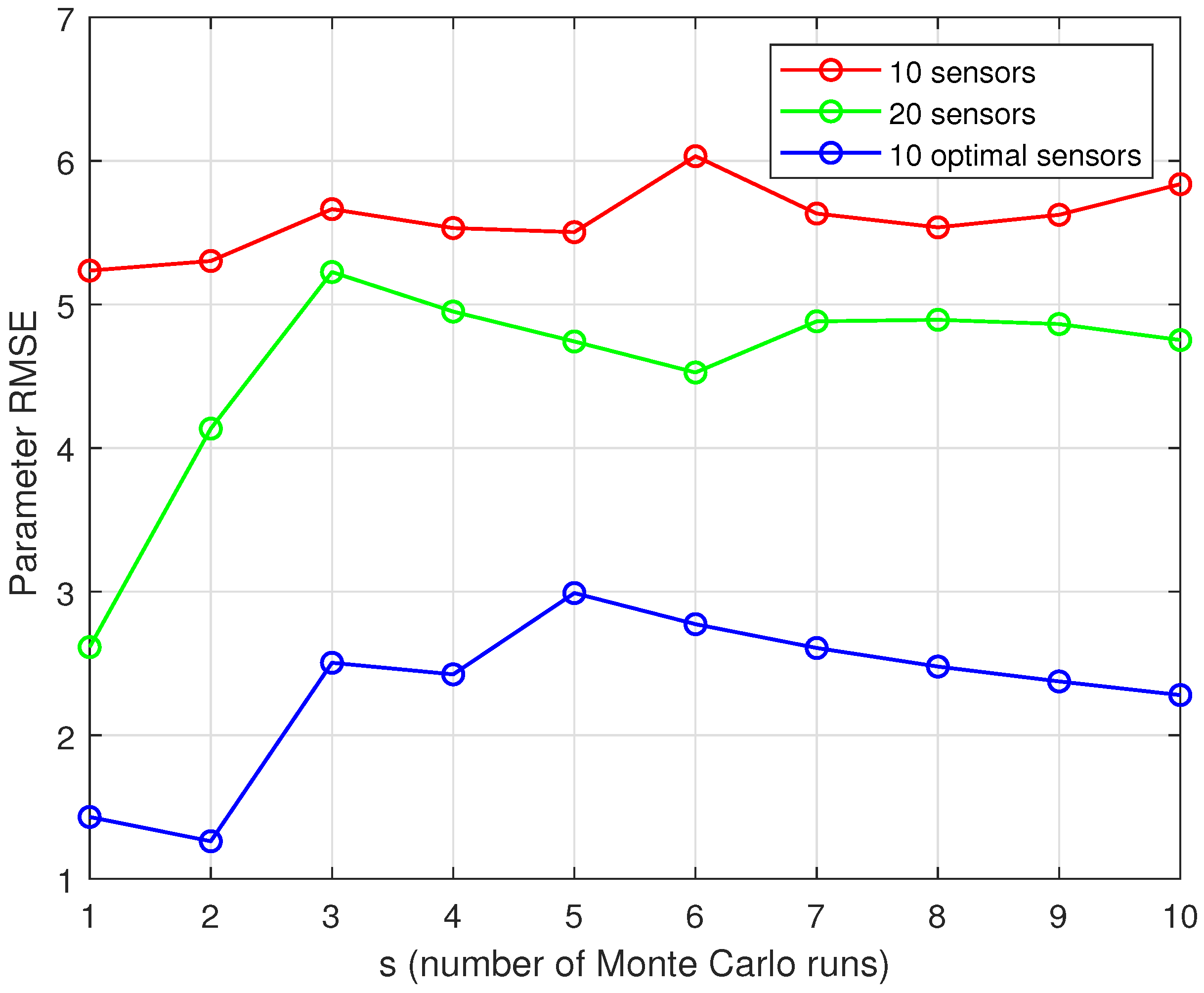
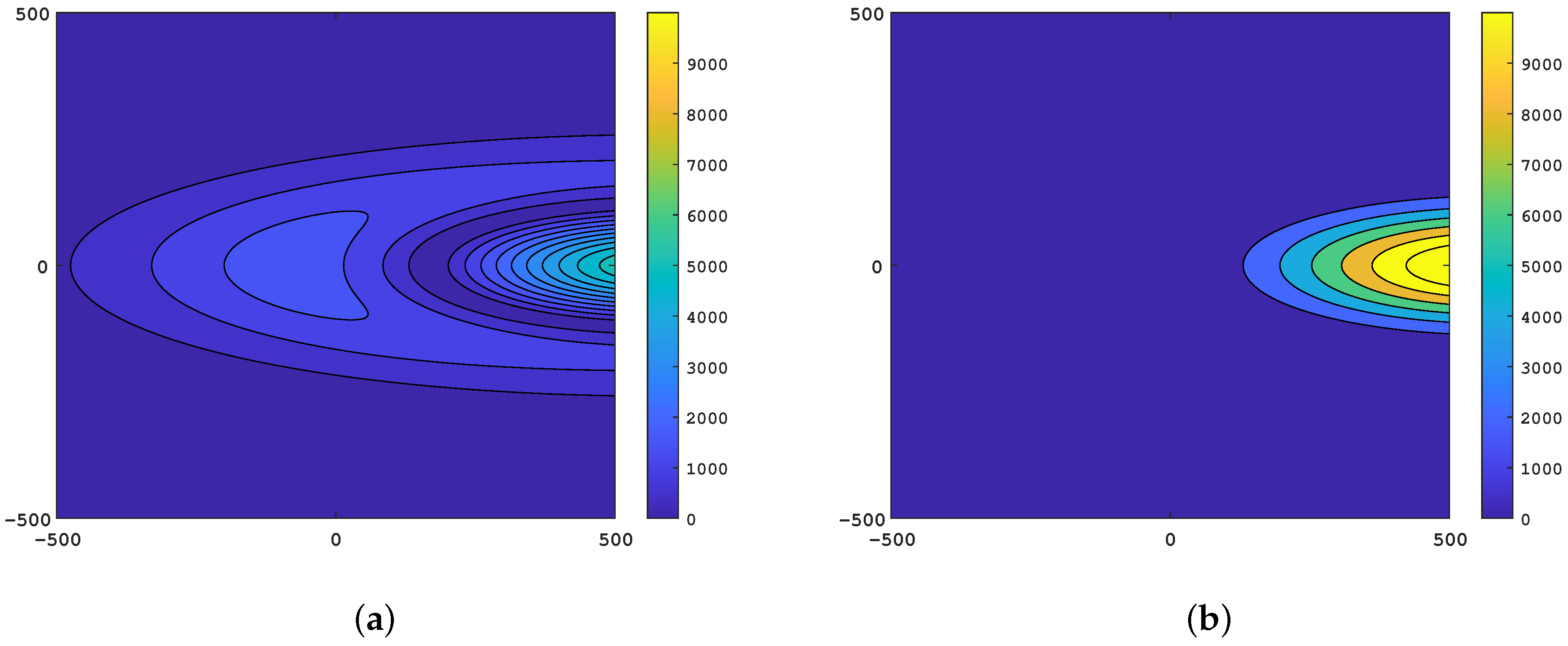
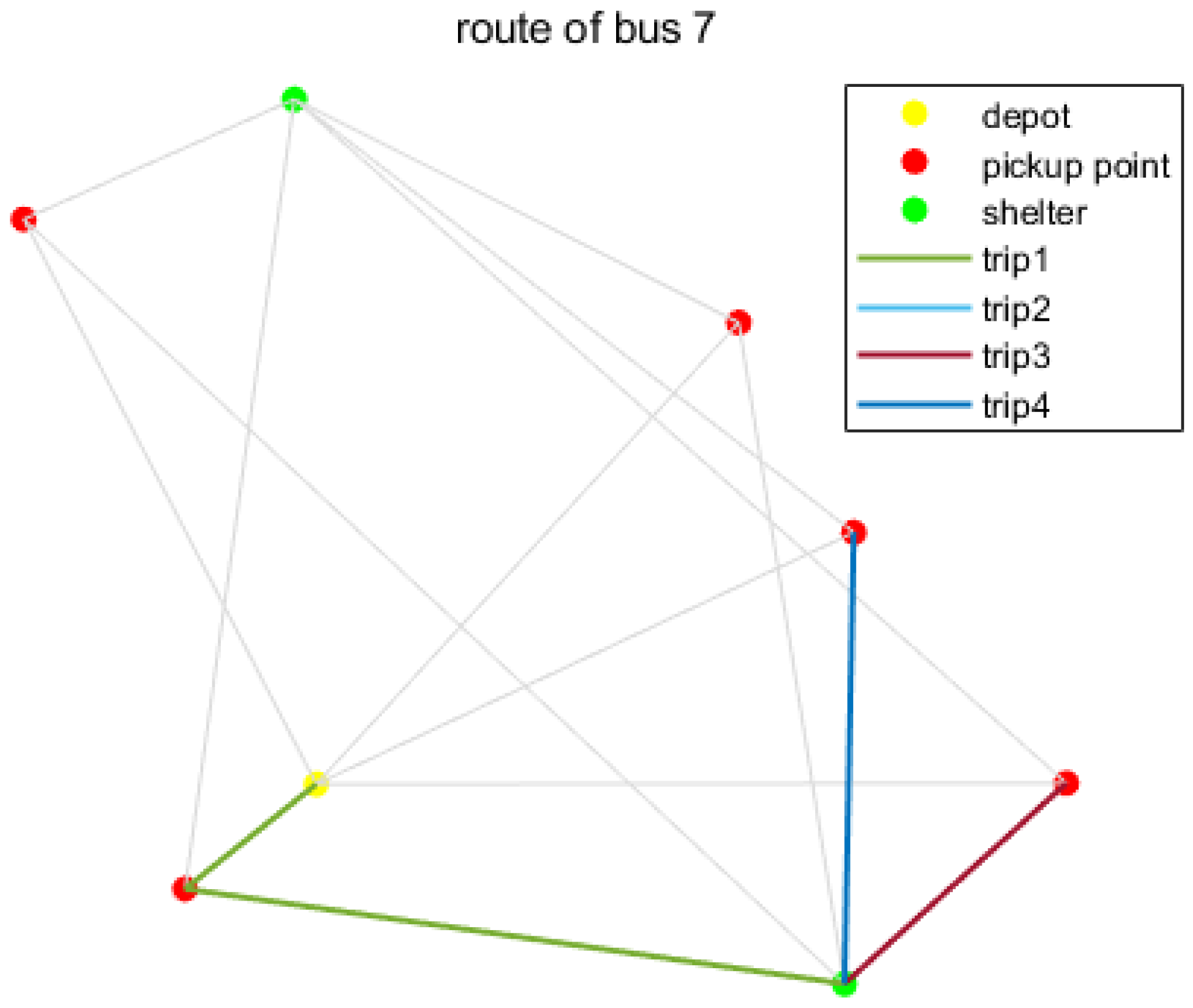

| UAVs | x (m) | y (m) | z (m) | t (s) |
|---|---|---|---|---|
| 1 | 173.027 | 244.802 | 26.545 | 608.697 |
| 300.989 | 184.739 | 121.332 | 616.847 | |
| 303.188 | 180.700 | 125.570 | 618.166 | |
| 318.715 | 174.929 | 120.500 | 619.946 | |
| 2 | −109.613 | −141.109 | 49.005 | 613.547 |
| −65.560 | −156.113 | 63.143 | 616.615 | |
| −39.174 | −159.356 | 69.787 | 618.815 | |
| −41.453 | −158.657 | 70.184 | 619.958 | |
| 3 | 299.851 | 247.711 | 4.064 | 615.587 |
| 256.180 | 284.296 | 56.412 | 619.909 |
| Instance | Depots | Pickups | Shelters | Buses | Capacity |
|---|---|---|---|---|---|
| 1 | 1 | 5 | 2 | 20 | 25 |
| 2 | 1 | 5 | 2 | 25 | 20 |
| 3 | 2 | 10 | 3 | 8, 12 | 25 |
| 4 | 2 | 10 | 3 | 5, 10 | 25, 30 |
| 5 | 2 | 10 | 3 | 10, 10 | 25, 30 |
| Instance | Gap | Compt Time (t) | Evac Time (t) | Radiation |
|---|---|---|---|---|
| 1 | 0% | 22.77 | 611.48 | |
| 2 | 0% | 35.80 | 611.48 | |
| 3 | 0% | 144.98 | 453.32 | |
| 4 | 0% | 231.73 | 473.42 | |
| 5 | 0.65% | time limit | 449.09 |
| Bus | Trips | Evac Time | |||
|---|---|---|---|---|---|
| 1 | 2 | 3 | 4 | ||
| 1 | 8 | 9 | 10 | 4 | 373.82 |
| 2 | 9 | 9 | 10 | 5 | 351.21 |
| 3 | 8 | 10 | 10 | 5 | 355.96 |
| 4 | 8 | 10 | 10 | 5 | 355.96 |
| 5 | 9 | 9 | 10 | 5 | 351.37 |
| 6 | 2 | 2 | 4 | 5 | 473.42 |
| 7 | 3 | 1 | 4 | 5 | 472.14 |
| 8 | 3 | 99.22 | |||
| 9 | 7 | 6 | 6 | 5 | 465.18 |
| 10 | 7 | 6 | 6 | 5 | 465.18 |
| 11 | 8 | 9 | 8 | 5 | 441.09 |
| 12 | 2 | 1 | 3 | 3 | 449.09 |
| 13 | 7 | 6 | 6 | 4 | 469.59 |
| 14 | 3 | 99.22 | |||
| 15 | 7 | 6 | 6 | 5 | 465.18 |
Publisher’s Note: MDPI stays neutral with regard to jurisdictional claims in published maps and institutional affiliations. |
© 2022 by the authors. Licensee MDPI, Basel, Switzerland. This article is an open access article distributed under the terms and conditions of the Creative Commons Attribution (CC BY) license (https://creativecommons.org/licenses/by/4.0/).
Share and Cite
Chen, B.; Li, Z.; Yang, Z. Nuclear Accident Emergency Response System: Radiation Field Estimation and Evacuation. Sustainability 2022, 14, 5663. https://doi.org/10.3390/su14095663
Chen B, Li Z, Yang Z. Nuclear Accident Emergency Response System: Radiation Field Estimation and Evacuation. Sustainability. 2022; 14(9):5663. https://doi.org/10.3390/su14095663
Chicago/Turabian StyleChen, Bo, Zhicheng Li, and Zaiyue Yang. 2022. "Nuclear Accident Emergency Response System: Radiation Field Estimation and Evacuation" Sustainability 14, no. 9: 5663. https://doi.org/10.3390/su14095663
APA StyleChen, B., Li, Z., & Yang, Z. (2022). Nuclear Accident Emergency Response System: Radiation Field Estimation and Evacuation. Sustainability, 14(9), 5663. https://doi.org/10.3390/su14095663





